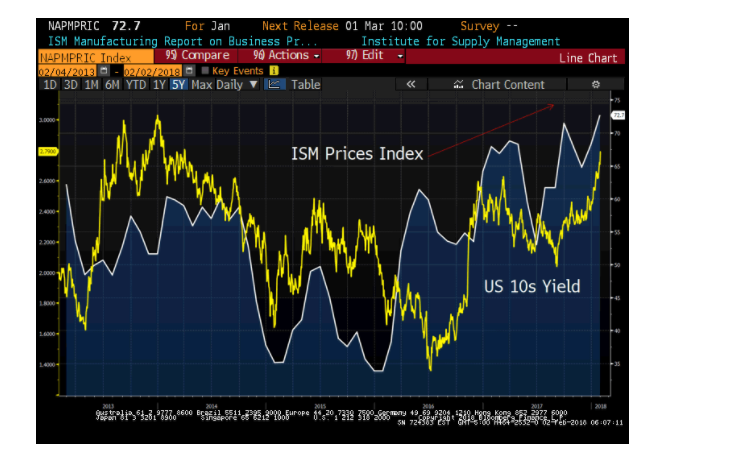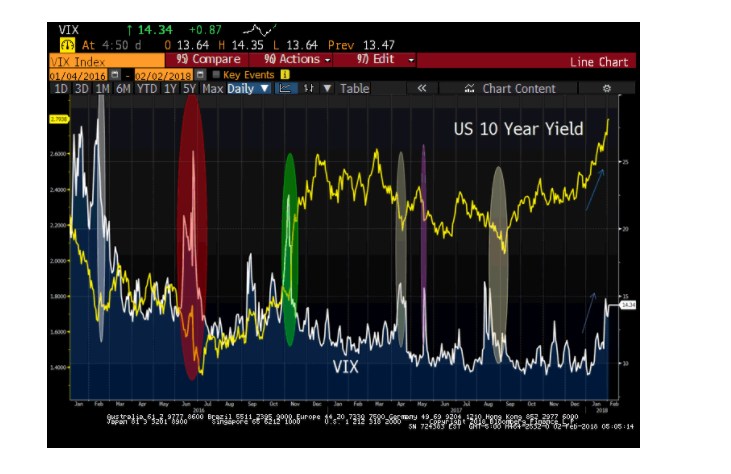Below, we continue our look at more data on yields, bond and stock markets, inflation and the increasingly thin ice upon which markets are trading.
This week saw a volatile Monday, with equity markets giving back all their gains for 2018 in a single trading day. Although hardly a “correction” of tremendous scale, it was at least refreshing to see that these hitherto gravity-defying markets can actually go down rather than perpetually up…
Inflation Ahead?
We’ve discussed inflation elsewhere, the question is: can we expect more? Our thoughts for 2018 is this: yes.
Why?
Because the markets are telling us. What are they saying? What are some key indicators we and you can be looking toward for guidance?
The Risk Parity Indicator
First, we are seeing the classic shift by conventional advisors toward a “risk parity” allocation. This is fancy speak for balancing hitherto stock-top-heavy portfolios toward a greater balance of stocks and bonds.
The traditional logic in a risk parity shift is based upon the old premise that pairing more bonds with stocks will minimize risk as portfolios and markets head into/toward more volatility.
For many reasons, we think this conventional wisdom is, well, unwise. These are not traditional markets, and hence traditional risk strategies may not provide traditional protection.
Bonds, quite simply, are not, in our opinion, a safe allocation, for reasons we’ve discussed at length in the bond section of this blog report, and which we’ll highlight again below.
Going “balanced” long in an over-crowded bond market (and stock market) makes little sense to us, as such a move presumes greater disinflation rather than inflation. We see inflation ahead, and hence question the logic of such a move.
Furthermore, given the massive distortions in bond and stock markets handed down by central bank intervention, bonds and stocks are acting in a correlated rather than uncorrelated fashion.
By going long both equities and credits, investors are more likely adding to risk, rather than “diversifying” (or risk-pairing) away from risk… As we’ve seen in late cycle inflationary environments (1980’s and 1990’s), stocks and bonds can fall together, and fall hard, rather than balance risk.
If such be the case, one better way to prepare for market volatility (so absent for soooo long) is not “risk parity,” but out-of-the-money puts on bonds or a stronger allocation to inflationary-hedging assets like commodities.
The “Flow” Indicator
Despite such concerns, we’re seeing investors making massive allocations/flows into passive ETF and Mutual Fund vehicles for bonds and stocks. The wild trend in January inflows into Passive MF and ETFs looks as follows:
2018: $105B
2017: $68B
2016: $18B
2015: $22B
If the tide turns in these overly-complacent markets, the sell-off in these vehicles will be fast and furious, and the losses in such bond and equity allocations could be as big as the relative gains will otherwise be in commodity trades.
Inflation Signs
We think there are increasing risks of a sell-off in bonds, as inflation hurts bonds, and inflation is frankly already here and coming.
Note, we’ve also written how inflation data is essentially incorrect (See: the inflation lie ). Despite BLS and Fed manipulation of inflation data, some signs are too obvious even for the Fed to gloss over.
*Wages Rising
For example, wages are finally rising, as the labor market knows (despite what the central banks are reporting) that prices are rising. As a result, wages need to follow suit. We’ve seen wages rise year-over-year by just shy of 3%, the greatest move since 2009.
*Prices Rising
Prices are also rising in the ISM manufacturing data—and rising fast, a further sign of inflation now and ahead. For well over 15 years, ISM prices moved in sync with the yield on the US 10 Year Treasury (US10YT).
When inflation concerns tanked in recent years, we saw a sharp disconnect between ISM prices and the US10YT.
Today, however, we are now seeing that this relationship has changed dramatically, as the below graph makes evident: bond yields and pricing are coming back in sync, suggesting inflation is forefront on the market mind.

Equity Flows
Meanwhile investors are acting, well a bit crazy as the “risk-on” momentum is continuing and peaks, as it often does, at precisely the wrong time. Just look at the inflows into equities at these market highs:
US Equity Long Futures Positioning:
2018: $405B
2017: $280B
2016: $185B
2015: $280B
2014: $240B
2013: $220B
2012: $155B
2011: $160B
2010: $150B
2009: $130B
2008: $280B
2007: $210B
2006: $180B
CFTC, GS data
As we head into February 2018, investors are pouring into equities like never before. Remember folks, the best time to go long any asset class is when they are under-crowded, not over-crowded. Unfortunately, no one is doing this…
People like to believe they know better, but rather than “buy low and sell high,” investors (as they always do) are chasing tops like sheep happily following (chasing) a shepherd toward a market cliff. You know how that eventually ends…
Rising Rates Due to Debt, Dollar, and Spending Fears not Fed “Guidance”
And if over-crowded trades (bubbles) aren’t enough of reason to consider both common sense and risk awareness, the obvious sensitivity bond markets have to rising rates should be another reason to think a bit more about risk than return in credits market in particular and larger markets in general.
We feel that a weaker USD, tax cuts, spending plans and euphoria over political promises and faith in more of the same couldn’t be coming at a worse time, as national and global debt levels have simply passed any sense of reason.
Such dollar-debasing, tax cuts and spending plans (which the US simply can’t afford—as this is not the Regan era or the Regan balance sheet) are likely juicing the markets at precisely the wrong time.
In short, policy makers are adding stimulus upon stimulus, in the way an athlete adds steroids upon steroids. That of course works for a while, until, well: it doesn’t. Just ask Lance Armstrong in France or Dick Fuld over at Lehman Brothers…
Dangerous Complacency
After so much Fed-induced low rates and money printing, price action has lulled investors into a dangerous complacency. Debt-driven policies are only adding to this complacency, which just means investors are adding more weight to their portfolios as the ice beneath them gets thinner and thinner and thinner.
But what will happen when normalized conditions (i.e. normalized corrections) return and the Fed (as well as the ECB, the BofJ etc.) realize they can’t control the Frankenstein Bull they created?
Bond Yields Rising (Rather than Falling) with the VIX
And if you are looking for more signs (rather than just opinions) about how things are starting to look a bit loopy despite this market’s blind faith in central bank “accommodation,” just look back to last week. The equities market lost nearly 4%, witnessing the S&P’s greatest drawdown in 2 years. (And even that was hardly much…) And then came Monday’s bumpy ride…
We actually saw some volatility.
In the past, as volatility and the VIX surged, bond prices (the “safe allocation”) rose and thus bond yields dropped. Recently, however, as the VIX jumped, so too did the yields on the US10YT—which means bonds fell as stocks fell… In sum: bond yields are moving higher with the VIX. Uh oh, …

Shorting is at Record Lows
If you’re still not concerned about these risk signs, here’s another indicator (rather than macro opinion) to consider. The put/call ratio (bear/bull ratio) on the equity market in general, and tech sector in particular, has never been so low, nor sentiment so high.
Tech shorts in January moved below the elevated range for the first time since the financial crisis of 08. In short, there are no shorts…
We think that’s a contrarian reason to be concerned, not euphoric.
What About All That Money Coming from Overseas?
Bulls, however, keep telling us that there is a lot of cash overseas which, thanks to the new tax laws and ongoing repatriation meme, will boost the markets even more.
We’ve talked about this bull scenario elsewhere. (See: Dow at 45,000? ). Perhaps this magic cash flow from across the pond will boost sentiment and hence markets.
Sentiment, after all, is a powerful thing, more powerful, often than reality. 2007, for example, saw only $40B in repatriation flows, whereas 2017 saw $650B. That’s something. And there’s likely more to come.
But here’s the reality/rub behind that “magic cash” held overseas: it’s not cash, it’s bonds.
Really?
Yep. Really.
This means that as all that so-called “cash” tries to come back to the US, it’s actually mostly bonds. The trillion-dollar question is this: what if there’s no buyer for those increasingly less sexy bonds?
Furthermore, more “repatriated” bonds flowing and selling into US markets means lower bond prices and hence higher bond yields (and hence higher rates) … Please: re-read that.
One reason we are seeing the first signs of a rate shock that the Fed can not control with a magic wand (despite their and this market’s belief in fairytales), is due in part to this so-called “repatriation” move—which is mostly a bond move/sale—and a dangerous one at that.
Summing it Up
For each of the foregoing reasons—rising wages, prices, complacency, ETF flows, put/call ratios, VIX-Yield moves, and bond “repatriation,”—we see rougher weather ahead for the bond market, and hence the over-all markets.
The great inflation question has so many opinions, and ours is just one of many. Nevertheless, we feel that bond yields are more than just tea leaves and we should all be concerned about what they are telling us.
Bond and stock markets may not be at the top, perhaps not even close to their top, but there’s little doubt they are over-crowded, over-confident and over-bought—all thanks to the dangerous euphoria which the central banks of the world have bought us at the expense of great debt, distortion and false confidence.
If you are a contrarian, you know that more money is made by going wisely (rather than arrogantly) against the crowd, and right now, the crowd is piling into misunderstood markets and misunderstood risk.
Again, that’s why we at Signals Matter are tracking flows, yields, trends and risk channels far more than just opinions. We are outperforming these markets by managing losses and targeting returns, unemotionally sticking to the data, not the media.
If you want to see those signals in action, become a subscriber rather than an opinion chaser.
And as always, be careful out there.




